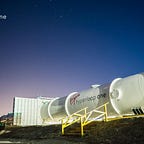World’s Fastest Highway Could Get Even Faster
German representatives make a strong case for a Hyperloop suspended above the Autobahn.
By Leslie Horwitz, Strategic Communications Manager, Hyperloop One
Eighty years ago the world’s land speed record was clocked at 430 kilometers per hour on the Autobahn, Germany’s famous, no-speed-limit highway, after it was shut down for racing. It has yet to be broken. That’s all set to change with an ambitious Hyperloop One Global Challenge proposal debuted by representatives from AECOM Germany at our Vision for Europe event last week.
The group envisions a Hyperloop suspended above nearly 2,000 kilometers of the German Autobahn covered with a solar-collecting photovoltaic (PV) roof and a high voltage DC power network. According to the proposal, this 30m wide PV-Roof could produce approximately 7,000,000 MWh/year, generating enough solar power and revenue from the transmission lines to run the entire Hyperloop system for no added cost, as well as refuel all the electric cars and trucks traveling on the road. If it sounds over-the-top ambitious, the German planners and architects behind the project don’t seem too fazed. “Don’t be afraid, it’s possible,” says Albin Toth, Lead Architect at AECOM.
The route would circulate throughout the heart of Europe’s biggest economy, starting with a link between Berlin and Hamburg but eventually linking around 18 million people, the 3rd largest seaport, and the largest airport by cargo transport in the EU.
Germany is known around the world for its punctual, well-oiled transportation systems. The country is the first among 160 nations for their trade logistics performance, according to the World Bank.
Its public transportation networks are first class. Berlin’s public transport system alone covers 2,600 kilometers throughout the city. But, transport demand shows no sign of slowing down — as Germany deals with congestion, pollution, and collisions. Stuttgart ranks among the top five most congested cities in Germany, and has been called the “the German capital of air pollution.”
Hyperloop will offer an alternative, CO2-free transportation network — helping Germany achieve the European Commission’s targets for a 20% cut in greenhouse gas emissions by 2020 and a 40% cut by 2030, compared to 1990 levels. The bottlenecks of the past were primarily related to the high capital cost of wind, solar and storage equipment. Those obstacles have largely been conquered by tech innovation and economies of scaled-up manufacturing. The primary bottlenecks of the future are the cost of high voltage direct current transmission lines to deliver the power from remote wind and solar locations, and solving the eminent domain issues of where to put those power lines. The Germany Hyperloop proposal is a bold attempt to cut through both of those bottlenecks at once.
According to the proposal, Power Pack battery racks with 4,400 kWh each are installed every kilometer. They will be able to store excess energy and the system will be able to transport energy along the way — this means maximum efficiency that allows wind energy produced in the north to be used in the south and solar energy from the south to travel north.
In addition to supporting the transportation tubes and the PV panels, the arch structure of the Hyperloop will support insulated high voltage DC cabling. This would save around 1 million Euro/km, considering the elimination of land acquisition for overhead power lines, and the combination with the two other system components — transportation and electricity production. Since the Autobahn falls under control of the Federal government, this will simplify the task of determining right of ways. AECOM estimates that the German Hyperloop will generate a return on investment within eight years, a unicorn number among transportation projects.
The value of this system lies in its synergy effect. “It’s not only a transportation system or a solution for transportation in Germany but also for producing energy and transporting energy,” explains Michel Eid, Renewable Energy Engineer at AECOM.
The Autobahn is already fast. A German Hyperloop would create the most efficient transport system ever created — and that’s one for the record books.
